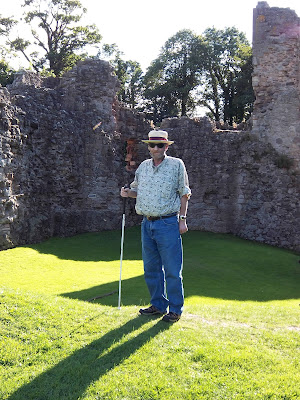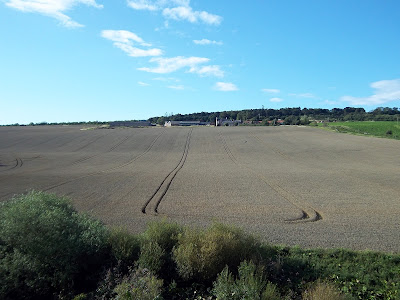In the National Gallery ‘Art through Words’ programme the chosen painting for March 31, 2012 was Hieronymus Bosch ‘Christ Mocked’ or ‘Crowning with Thorns’ This has an Easter theme to it and the passion can be read from the Gospel of St Mark.
http://www.nationalgallery.org.uk/whats-on/calendar/art-through-words-31-march-2012
On the day, the National Gallery was preparing for a full security check in line with London preparing for the Olympic Games. When there are crowds waiting, security manages to escort visually impaired people through the checking process. It is something we will all have to get used to as the Games get closer.
Our describer Karly Allan met us on the ground floor and we went upstairs - a lift is available. There were about 20 of us including companions. After introductions we settled down to an A2 sized poster reproduction of the painting, almost the size of the original itself.
Bosch was born in the area around Antwerp. Many of his paintings were done in the late 1400s and this would put him in the same period as say Richard III in England. After the historical context and background to Netherlandish Art and Northern European Reformation around 1500, Karly settled on the geometry.
Within the frame is a 5 sided figure slightly askew (an inverted pentagon with about 18 degrees of clockwise rotation). At the corners are 4 tormentors or torturers of Christ, who is off-centre on the top side to the right of the centre of the pentagon. With the 5 people there are five pairs of hands and we spent some time locating arms, hands and shoulders!
The off-centre nature of the composition with some diagonal lines gives the painting some sense of motion. It is slightly unnerving and suggests violence, which is doubtless the intent. I commented in the Zoffany post that in compositions Zoffany managed to suggest a frozen scene of the action in his paintings of theatrical and classical or biblical scenes. The Bosch painting has characters who appear to be different in their actions as one moves round the group. Christ himself appears calm though violence is occurring and a crown of thorns is placed just above the head in a halo like appearance.
The characters top left and bottom left are clothed in green and raspberry red respectively, the lower one is in profile with a bulbous and hooked nose. On the top right the character is dressed in what looks like a dog collar with spikes and is brandishing a club which may have had spikes though these have been erased. This character reminded me of the executioner in Mel Brooks Movie ‘Blazing Saddles’ (Now that I think of it, the bottom left character looks like the Marty Feldmann character in Mel Brooks Young Frankenstein!)
The figure on the bottom right seems to be pulling off the white robe on Christ’s body. It is almost as if he were pulling back a curtain and this gives a diagonal from the bottom right of the painting into the centre. Other lines which give some idea of movement are discernible on the peripheral vision. Some of those attending could detect detail such as the crescent and 6 pointed star on the bottom left character clothing. Clusters of oak leaves and an acorn on the tormentor top right and an arrow which is on the turban on the top left character who also has a metal clad arm and hand.
This painting would have been commissioned as a private “devotional” item. It is oil on wood (oak) and has a wooden frame in Gallery Room 5.
We then moved to the painting in groups. There are arms to borrow for guidance and I chatted with a couple I had met in January. The surprise is “seeing” the painting in real life. The colour contrast was much clearer. I am rather weak on green and the profile of those clad in red was much sharper as was the thinning of the white on Christ.
At this point it was mentioned that this was the only Bosch in the collection. The same had been said about Albrecht Durer. I have seen Bosch paintings in real life at the Prado in Madrid. As coincidence would have it, the friend who had taken me to the Zoffany exhibition had been with his wife to Madrid and had sent me a postcard of the Garden of Delights which I showed to Karly.
Many thanks to the National Gallery team for these monthly meetings. They give us another door to explore more art by just asking.
For Chemists: The structure of this painting can be described as Furan, with the oxygen placed at the bottom of the heterocyclic ring. The carbons represent the heads of the torturers. The Carbon-Hydrogen bonds represent the arms of the torturers. The white pigment has become abraded and shows the workings of the body of Christ. The green pigment is made from an unusual compound of tin, oxygen and the isotope of hydrogen with 2 neutrons.
Postscript
After the talk I was taken back to the Sainsbury Wing where I made some enquiries about the Turner Exhibition. Security took me outside as the heightened security exercise was underway. I was enjoying a banana outside the gallery when the peace and tranquillity of Trafalgar Square was ruined by someone playing the bagpipes, badly. I enjoy bagpipe music but this was not only a bad player but the tune was Highland Cathedral. I can only think that this was the latest Cabinet Office stunt to control the British Masses.
Further dates were handed out at the meeting and when I got home Miranda Baxter sent me the programme which my computer can read to me and which I can cut and paste into the blog. The National Gallery needs an idea of numbers in order to have reproduction posters and highlights magnified for those attending. All sessions are free. Please call 020 7747 5820 to guarantee a place.






















